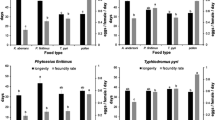Abstract
The larval feeding traits and oviposition behavior of ten phytoseiid mite species were investigated in the presence and absence of prey. Results showed a correlation between prey preferences, the manner of oviposition, and larval feeding behavior. Species with larvae that must feed to develop preferred prey species that were distributed sparsely and laid their eggs in a scattered fashion. Species with larvae that do not need to feed to develop preferred prey species with a high aggregation and laid their eggs in a clumped fashion. The results suggest that nonfeeding larval behavior may be an adaptation to avoid sib-cannibalism, which occurs when eggs are oviposited closer together.
Similar content being viewed by others
Author information
Authors and Affiliations
Additional information
Received: October 13, 2000 / Accepted: December 15, 2000
About this article
Cite this article
Chittenden, A., Saito, Y. Why are there feeding and nonfeeding larvae in phytoseiid mites (Acari, Phytoseiidae)?. J Ethol 19, 55–62 (2001). https://doi.org/10.1007/s101640170018
Issue Date:
DOI: https://doi.org/10.1007/s101640170018




